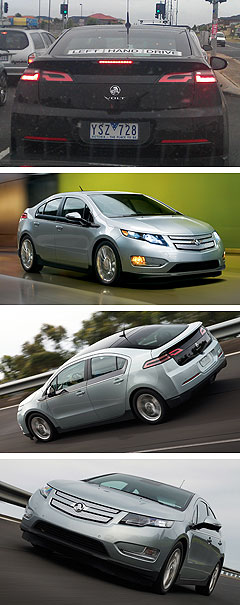GM Volt given clean bill of health
BY RON HAMMERTON | 23rd Jan 2012

The formal investigation by the National Highway Traffic Safety Administration (NHTSA) concluded that the Chevrolet Volt and other electric vehicles pose no greater fire risk than conventional petrol-powered vehicles.
But the safety chiefs nevertheless announced a new set of interim guidelines on the handling of battery-equipped vehicles to reduce the danger to emergency crews and others after crashes.
Washington-based NHTSA found that no fires had been reported in Volts in the field, and the chances of that happening had diminished because GM had taken steps to reinforce the steel protection for the batteries on all Volts, including those already in customer hands.
The drama started last year when a Volt was subjected to the severe side pole impact test that apparently damaged the 16kWh battery pack, causing fluid to leak.

The wreck, which was also rotated in a “rotisserie test” that simulates a roll-over subsequent to the crash to check for leaks, was left in a holding yard for three weeks before the vehicle caught fire, burning several nearby vehicles as well.
The fire was blamed on leaking chemicals that crystallised, reacting with electronics within the battery case – a scenario later replicated in subsequent laboratory tests by NHTSA engineers, triggering the formal investigation in November.
GM responded with tests of its own, announcing early this month that it had developed modifications to protect Volt from a similar outcome in real-world crashes.
These measures included more steel protection around the under-floor battery case, a sensor to detect fluid leaks and a special bracket to prevent overfilling.
The modifications have been made to all Volts coming down the production line since the Christmas holiday break at the Michigan factory, and GM is rolling out a service campaign in the US to make the changes to existing cars.
The same tweaks will be incorporated in Volts sold in Australia, where GM Holden received official Australian Design Rule approval for the pioneering range-extender hatchback on December 9 ahead of its sales roll-out in the second half of this year.
Left-hand drive Volts have been spotted testing on Victorian roads recently.
GM welcomed the news that NHTSA was closing its investigation into the Volt, saying the modifications it was making to the Volt were “to make a safe vehicle even safer”.
“The engineering enhancements that General Motors announced on January 5, 2012, will provide additional protection for the battery, minimising the risk of a post-crash fire in the days and weeks after a severe crash and roll-over,” the company said in a statement.
NHTSA said that, based on the available data, it did not believe that Chevrolet Volts or other electric vehicles posed a greater risk of fire than petrol-powered vehicles.
“Generally, all vehicles have some risk of fire in the event of a serious crash,” it said. “However, electric vehicles have specific attributes that should be made clear to consumers, the emergency response community and tow-truck operators and storage facilities.
“Recognising these considerations, NHTSA has developed interim guidance – with the assistance of the National Fire Protection Association, the Department of Energy and others – to increase awareness and identify appropriate safety measures for these groups.
“The agency expects this guidance will help inform the ongoing work by NFPA, DOE, and vehicle manufacturers to educate the emergency response community, law enforcement officers and others about electric vehicles.”The Volt, which has been rated a five-star safety performer in independent crash tests in the US, can travel up to 56km on a single battery charge before the 1.4-litre petrol engine kicks in to generate power to extend the range to about 600km, depending on speed and other factors.